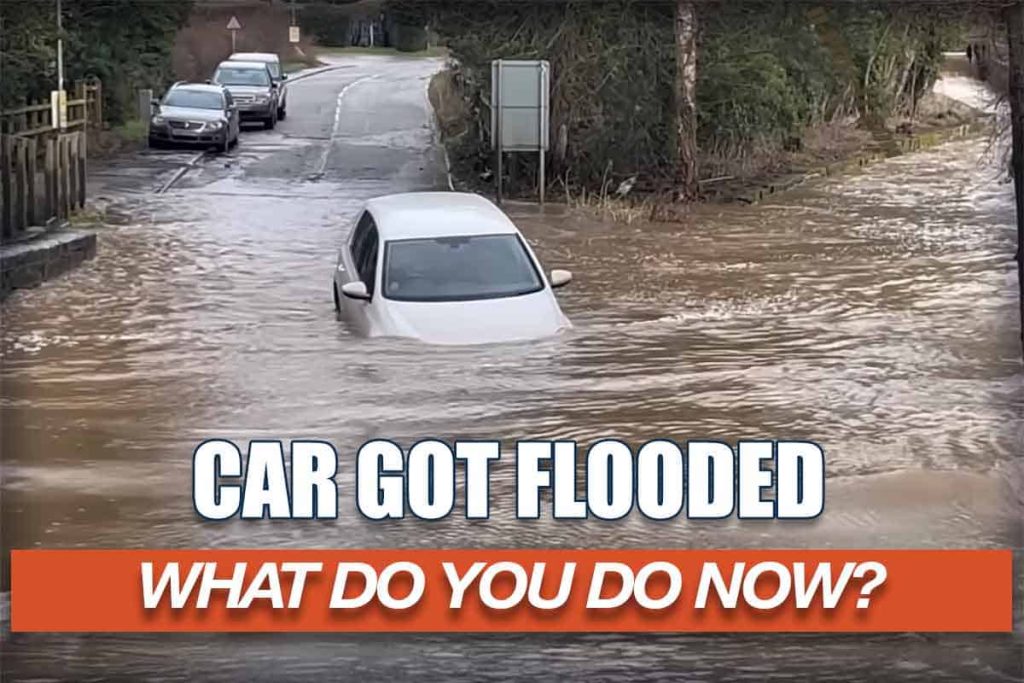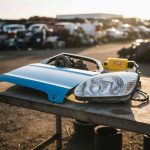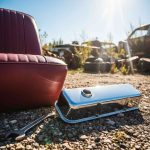Hurricanes are a force to be reckoned with, and your car can suffer severe flood damage during such natural disasters. We want to walk you through the steps to take if your car or truck was flooded in a hurricane. From insurance claims to car repairs, we’ve got you covered.

Introduction: The Reality of Flood-Damaged Cars in a Hurricane
Hurricanes are devastating events that can cause extensive damage to property, including your car. The aftermath of a hurricane often leaves many cars flooded and owners confused about what to do next. This article aims to guide you through the steps to take if your car gets flooded during a hurricane.
Why Comprehensive Coverage is Required
If your car has been affected by a flood, the first thing you should do is contact your insurance company. Comprehensive coverage is essential for such situations as it covers not only flood damage but also other disasters like fire, theft, and vandalism. In states like Florida, comprehensive coverage is optional unless you have an auto loan. So, make sure your insurance policy includes comprehensive coverage to avoid any financial setbacks.
First Steps: What to Do if Your Car or Truck Was Flooded in a Hurricane
If you find your car submerged or partially submerged in flood water, here are the immediate steps to take:
- DO NOT attempt to start your car: Starting a flooded car can cause even more damage to the engine and electrical system.
- Document the Damage: Take photos of your car and the surrounding area for insurance purposes.
- Disconnect the Battery: This will prevent electrical shocks and further damage to the electrical components.
Why You Shouldn’t Start a Flooded Car
Starting a car that has been exposed to water can lead to severe engine damage. Water in the engine or fuel system can cause irreversible harm. Always have your car inspected by a mechanic before attempting to start it.

Documenting the Damage: What Insurance Companies Need
Insurance companies require thorough documentation to process your claim. Take photos of the flood-damaged car and any other damage that has occurred. This will expedite your insurance claim and help in assessing the extent of the damage.
Electrical System and Components: What to Check
Water and electricity don’t mix well. Check the electrical components of your car, including the battery, lights, and dashboard. If you notice any irregularities, contact a towing service to get your car to a mechanic for a detailed inspection.
The Role of Your Mechanic in Assessing Flood Damage
A professional mechanic can provide a comprehensive inspection of your flood-damaged car. They will check the oil and transmission fluid, look for signs of corrosion, and assess the level of damage to determine whether the vehicle is repairable.
Repair or Replace? How to Decide the Fate of Your Flooded Car
If your car has suffered extensive flood damage, it may be declared a total loss. In such cases, it’s often more economical to replace the car rather than repair it. Consult your insurance agent to discuss your options.
How to Dry Out Your Car to Prevent Further Damage
Drying out your car is important to prevent mold and further water damage. Use a shop vac to remove excess water and open all doors and windows to let the car dry. If the vehicle was exposed to salt water, you’ll need to take additional steps to prevent corrosion.
Buying a Used Car After a Hurricane: What to Watch Out For
If you’re in the market for a used car following a hurricane, be cautious. Check the vehicle history report and look for signs of flood damage. Always have the car inspected by a mechanic to ensure you’re not buying a previously flooded vehicle.
Electric vehicles and salt water damage
Electric Vehicles and Salt Water Damage: A Special Concern
Electric vehicles (EVs) present unique challenges when it comes to flood damage, especially if exposed to salt water. Salt water is highly corrosive and can quickly degrade the electrical components of an EV, including the battery and wiring. Unlike traditional vehicles, where the primary concern might be the engine or transmission, the electrical system is the heart of an electric vehicle.
If your electric vehicle has been exposed to salt water, it’s crucial to have it inspected by a mechanic who specializes in EVs as soon as possible. The corrosive nature of salt water can lead to long-term issues that may not be immediately visible. This includes potential damage to the battery’s ability to hold a charge, degradation of electrical connections, and even risks of electrical fires. Your insurance policy may have specific clauses related to electric vehicles and flood damage, so be sure to consult your insurance agent for guidance.
Can a Flood Damaged Car Be Fixed?
The answer to whether a flood-damaged car can be fixed is not straightforward and largely depends on the extent of the damage. If the flood water has only reached the bottom of the car and hasn’t entered the interior, there’s a good chance that the vehicle can be repaired. However, if the water level has reached the engine or the interior of the car, the damage could be severe and may result in a total loss. Electrical systems are particularly vulnerable to water damage, and even a small amount of water can wreak havoc on a car’s electrical components.
It’s important to have a comprehensive inspection done by a qualified mechanic to assess the damage accurately. They will check the engine, transmission, electrical system, and other vital components to determine the feasibility of repairs. If the vehicle is deemed repairable, it’s essential to replace all fluids, thoroughly clean the interior, and possibly replace damaged parts. However, it’s worth noting that even after repairs, a flood-damaged car may have a lower resale value and could be prone to future issues. Therefore, it’s vital to weigh the costs and benefits before deciding to repair a flood-damaged vehicle.
Every year, over 1 million vehicles get flooded in the USA alone, but not all vehicles end up at a local junkyard; hundreds of thousands of them are fixed and sold back into the market.
FAQs
My car was flooded in a hurricane; what should I do first?
The first thing you should do if your vehicle was flooded is call your insurance company and inform them about the situation. You may need to file a claim if you have comprehensive car insurance coverage for flood damage. It’s also essential to avoid starting your car until it’s been inspected to prevent additional damage.
What does it mean if my car is tagged as ‘salvage’?
If your car is tagged as ‘salvage’, it means that the damage to your car, possibly from a hurricane or other disaster, exceeds the value of the car. The car is considered totaled, and the insurance company will pay you the value of the car before it was damaged instead of paying for the car repair.
How do I inspect a flooded vehicle?
Inspecting a flooded vehicle involves multiple steps: checking for any exterior damage if possible, looking for signs of rust or muddy water inside the car, and checking the oil dipstick for water contamination. Make sure to take photos of all visible damage to your car and submit these to your car insurance company.
How do I know if my car is repairable after being flooded?
Whether your vehicle is repairable depends on the extent of the flood damage. The most common issue is water getting into the engine or the oil pan. Minor flooding that hasn’t reached the level of the engine can often be repaired, while more severe flooding could result in a car being classified as a total loss by your auto insurance.
What will my car insurance cover if my vehicle was flooded in a hurricane?
Car insurance coverage varies by policy. Comprehensive insurance usually covers damage to your car from natural disasters like hurricanes, including if your vehicle was flooded. However, the payout will be capped at the car’s current market value before the storm. It’s important to read your policy or call your insurance company to understand your coverage fully.
What does flood damage to a vehicle look like?
Flood damage to a vehicle may include, but isn’t limited to, rust and corrosion, mud and debris in hard-to-clean areas, damp or musty odors, failed electrical components, and water stains or faded upholstery. Checking the oil dipstick may also reveal water in the oil.
What should I do to repair my flooded car?
The process and feasibility to repair a flooded car depend on the extent of the damage. Common steps for flooded car repair include eliminating standing water, drying the car, cleaning and disinfecting all parts, changing the oil, and replacing damaged components. If serious engine damage has occurred, though, the vehicle may not be repairable.
What risks are associated with buying a flood-damaged car?
When shopping for a used car, it’s important to be aware of potential red flags indicating it has been flood damaged. While sellers are required to disclose this information, it isn’t always done. Flood damage may lead to various issues, including an increased risk of mechanical and electrical failures, rust and corrosion, and potential health hazards due to mold and bacteria.
My car was partially flooded. Can I still drive it?
It’s critical to have your car inspected before attempting to drive it after flooding, even if it was only partially flooded. Water can cause significant damage to various car components, and driving the car before getting it checked could cause further damage. If you suspect your car has been flooded, contact your car insurance company and have a professional mechanic inspect it.
How can I protect my car from future floods?
To protect your car from future floods, consider these precautions: If you know a flood is likely, try to move your car to higher ground or to a multi-storey car park. Ensure your insurance coverage adequately covers flood damage. Regularly check weather warnings so you can act fast during a hurricane or similar situation to reduce the chances of your vehicle being flooded again.




